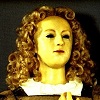Most of the following
images open in a new window for a detailed study.
The most important
feature of men's hairstyles in the 1660s is that it was supposed to look
natural, but to be at least wavy, and even better, to be curly. It appears
that the early periwig strove to imitate natural hair with the gentlemen
hoping to get away with them and being mistaken for having a head of lovely,
long, curly, healthy hair. Often the wigs made use of the natural hair,
particularly in the front/at the forehead, where it was pulled through
the wig to appear more natural. Samuel Pepys Mentions that he had been
wearing a periwig for a while, but then he grew his hair back long from
being shaved - hair was shaved or clipped very short underneath wigs,
otherwise the hat beneath the wigs would be unacceptable and the cut off
hair was used for a new wig - but after a while decided it was so much
less hassle to just put on a wig instead of trying to keep the natural
hair clean. This particularly true in an age where hair was washed less
tan often, there are recipes for a hair water which promises to keep the
hair clean for the following year. Hair was combed, but not washed often,
and brushes had not been invented yet. Instead wood, horn or bone combs
were used.
Samuel Pepys,
Diary, 1663
November 2nd. I heard the Duke say that he was going to wear a perriwigg;
and they say the King also will. I never till this day observed that
the king is mighty gray.
 1650s 1650s
Dutch man with his natural, wavy hair. |
 1660 1660
French Beau with what appears very much to be a wig. Full bodied
and very curly. |
 1660 1660
Dutch man with natural hair, long and parted in the centre, almost
straight. |
 1660 1660
French page with his natural hair, wavy and long. |
 1660 1660
French page with natural hair, wavy and parted in the middle. |
 English
gentleman with what appears natural hair, if it is, it is dark and
wavy, but it might be too perfect for being natural. English
gentleman with what appears natural hair, if it is, it is dark and
wavy, but it might be too perfect for being natural. |
 The
second Duke of Buckingham in what is an obvious wig, due to its frizzy
nature. They did not stay in fashion very long. The
second Duke of Buckingham in what is an obvious wig, due to its frizzy
nature. They did not stay in fashion very long. |
 Admiral
de Ruyter very sober with his natural hair which only goes to the
neckline and is receding in the forehead. Admiral
de Ruyter very sober with his natural hair which only goes to the
neckline and is receding in the forehead. |
 The Duke of Lauderdale in what must be a wig, because for a man his
age it would be most uncommon to have such thick, curly long hair.
The wig is made to appear natural. The Duke of Lauderdale in what must be a wig, because for a man his
age it would be most uncommon to have such thick, curly long hair.
The wig is made to appear natural. |
 Dutch
gentleman in his own hair, slightly wavy. Dutch
gentleman in his own hair, slightly wavy. |
 1661 1661
Charles II at his coronation with long black curly hair which
he prided himself of, but the painting glorifies its perfection and
might show a wig. |
 1661 1661
The Duke of Abermarle at Charles II's coronation procession in
what appears to be natural hair or a very natural looking wig. |
 1661 1661
Graf Quellin wearing a skull cap, perhaps to hide a bald patch
and with long curly hair, which points more towards a wig though. |
 1661 1661
The Duke of York in glorified natural hair or a very natural wig,
parted in the middle, long but less curly. |
 1661 1661
The Duke of York with the same wavy hair but what appears to be
bangs. |
 1662 1662
Young Dutch gentleman with his natural hair. |
 1662 1662
Dutch gentleman with his natural hair worn in a very simple and
sober style. |
 1662 1662
Gentleman wearing a periwig which is slightly frizzed and the
ends curled together in large rolls, similar to the later campaign
wigs which have knotted ends. |
 1664 1664
Dutch elderly man with his natural hair which is only neck length
and a skull cap which probably hides a bald patch, taking the receding
hairline at the forehead into consideration. |
 1664 1664
The Duke of Lauderdale in what appears to be a wig with his natural
hair pulled through at the forehead to make it look more natural,
but the wig is more frizzed than the forehead. |
 1667 1667
John Leslie in a very curly full bodied periwig. |
 1667 1667
Lord David Hay with his natural hair in soft waves. |
 1667 1667
Robert Kerr in a frizzy periwig. |
 1667 1667
Sir Norton Knatchbull in sombre dress and with his natural hair. |
 1669 1669
A wax effigy of the Danish Prince Jorgen showing a periwig as
it would have been worn, made in the period. |
 Prince
Rupert in either his natural hair or a very natural wig with the hair
at the forehead pulled through. Prince
Rupert in either his natural hair or a very natural wig with the hair
at the forehead pulled through. |
 Prince
Rupert again, but this time wearing a much fuller periwig. Prince
Rupert again, but this time wearing a much fuller periwig. |
 1660-70 1660-70
Wig worn by Alexander Peden who was a Covenanter. It shows how
wigs in the period were made. |
|









